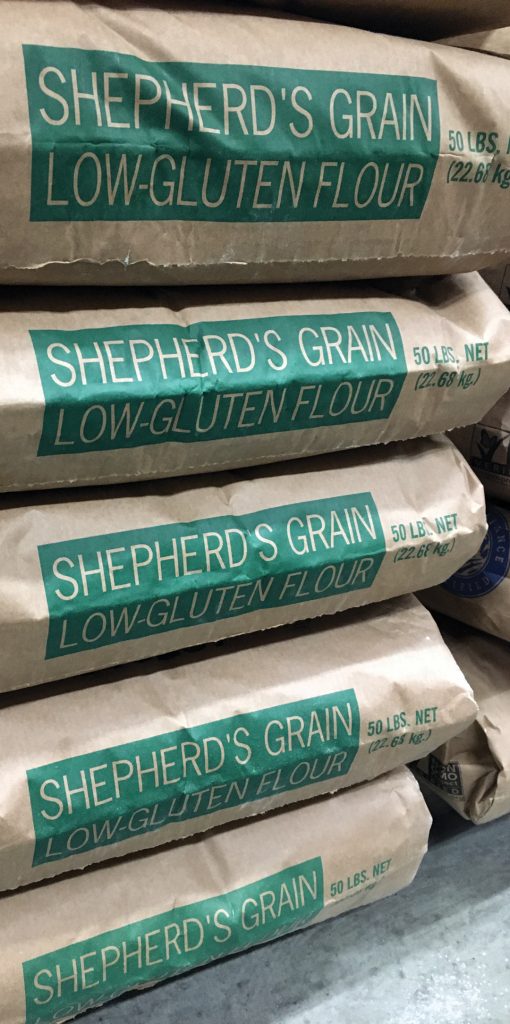IF YOU’VE GOT IT, FLAUNT IT
BY MELANIE EPP • ABOVE PHOTO COURTESY OF COLE’S AG MEDIA
It’s no secret that Canada is one of the world’s top producers of consistently high-quality wheat. Millers in countries such as Ecuador, Indonesia and Japan rely on Canadian wheat to produce top-quality flour for their customers. And while American millers contend with wheat consistency issues, new marketing opportunities for Canadian wheat have popped up in that country. In a highly competitive market, quality is what sets Canada apart from its competitors.
Canada’s global reputation as an exporter of high-quality, high-protein wheat is in large part due to the country’s rigorous grain grading and variety registration system, which guarantees agronomic stability for farmers and consistent quality for end-users. The country’s variety registration system uniquely governs variety development, registration, release and commercialization.
Canada’s place in the global wheat trade pecking order is being tested. The high volume of grain being exported from the Black Sea region has created a significant shift in the marketplace (see “Surfing the Black Sea” in the October 2019 issue of GrainsWest). It is therefore imperative Canada protect its brand as a producer of top-quality grain, or face losing a critical competitive advantage.
“Canada’s brand reputation is among the best,” said Patti Miller, Canadian Grain Commission (CGC) executive division chief commissioner. “If buyers come back each year to buy Canadian grain it’s because they know what they are going to get.”
Fifteen years ago, the Black Sea region of Russia and Ukraine exported virtually no grain. Today, it exports approximately 50 million tonnes of wheat annually. Production is low-cost and most of the grain is within trucking distance of ports. The industry doesn’t face the large transportation cost that Canadian farmers do.
“It’s going to be difficult for us to compete just based on price,” said Cam Dahl, president of Cereals Canada. “We really do need to work to our strengths and preserve that brand. The delivery of consistent, high-quality products is critically important to the competitiveness of the Canadian cereal crops.”
A UNIQUE SYSTEM
Canada’s variety registration process is a unique and somewhat complex system managed by the Canadian Food Inspection Agency (CFIA). Under the Canada Seeds Act, CFIA has the authority to register wheat varieties. It can also give recommending committees the authority to set criteria for new variety registration. The CFIA also approves and issues the variety registration.
Under the same act, the CGC assigns the new wheat varieties to an appropriate class and has the authority to deny a variety’s entry into a wheat class. The commission also maintains the wheat class variety eligibility list.
The Prairie Grain Development Committee (PGDC) recommends new varieties for registration through its four recommending committees: wheat, rye and triticale; oats and barley; pulses and special crops; and oilseeds.
The team that forms the Prairie Recommending Committee for Wheat, Rye and Triticale is tasked with assessing varieties as they go through co-op trials. Through a voting process, its task is to recommend varieties for registration.
Once recommended, varieties then require approval by the CGC, and their registration must be approved by the CFIA.
Across the Prairies, wheat trials are conducted at various locations. Under regional environmental conditions, new varieties are compared to previously established ones over a three-year trial period. For CWRS, the most widely planted class, three co-op trials are run in three locations.
Independently of each other, three PGDC evaluation teams assess grain for disease resistance, agronomic characteristics and overall quality. These teams are comprised of industry experts. The quality evaluation team, for example, is made up of cereal scientists, grain handlers and marketers as well as baking and milling representatives who understand the needs of wheat customers. “They understand the quality parameters that wheat is being evaluated for,” said Lisa Nemeth, the Canadian International Grains Institute’s director of markets.
The objective of the quality evaluation team is to recommend varieties with milling and end-product characteristics that meet or improve upon class specifications. New varieties recommended for registration must meet or improve upon the traits of established varieties.
As part of the variety registration process, all three PGDC teams must recommend a variety for registration. When a variety does not receive unanimous approval, the cultivar voting panel subcommittee assesses its combined characteristics. The panel then votes on whether to recommend the variety for registration.
End-users such as millers value the consistency of Canadian wheat. “They know when they’re purchasing a shipment based on class and grade that there is a quality expectation they can have, and that it’s based on this system established in Canada,” said Nemeth. “Millers are delivering sometimes to very large customers, sometimes large industrial bakeries that have strict quality requirements. Being able to rely on a supplier to have consistent quality is huge for them.”

U.S.-based Shepherd’s Grain purchases durum varieties from two Alberta farmers, who said Canada’s registration system facilitates such opportunities. Photo courtesy of Shepherd’s Grain.
In terms of quality wheat production, Canada’s biggest competition is the United States. According to Geoff Backman, Alberta Wheat Commission and Alberta Barley business development and markets manager, the U.S. has recently experienced consistency problems.
“Something we’ve been hearing out of the U.S. is that the consistency in quality attributes has been decreasing,” said Backman. The issue came to his attention while attending a crop industry meeting in the U.S. at which millers and production co-ops met to discuss options to address quality variability.
“When you’re a miller and you’re producing a product like flour, you want to be able to say to your bakers that, ‘every time you use this flour, you’re going to get the same result when you’re making a loaf of bread,’” said Backman. “If you’re looking at varying quality of wheat as a miller, you’re having to do a lot more adjusting to your process to ensure that the quality of that final flour to your bakers stays the same. It’s a lot of extra work.”
Canadian wheat importer Juan Carlos Arriola, director of plant operations at Moderna Alimento in Ecuador, agrees. The company processes 700 tonnes of Canadian wheat daily, and Ecuador imports 300,000 tonnes of Canadian wheat annually.
“We use Canadian wheat for everything,” said Arriola, a member of the quality evaluation team of the PGDC. With more than 20 years’ experience in milling, he provides valuable feedback on end-user requirements. “Every company in Ecuador that produces flour for bread is buying CWRS from Canada,” he said.
Millers need to have a wheat class that is dependable, and consistency is key, said Arriola. “You don’t want to adjust your process every time you receive a new vessel of wheat. The Canadian grading system provides you that kind of consistency on the quality side.”
There are distinct differences between how the Canadian and U.S. systems operate. In the U.S., for instance, Dark Northern Spring wheat is more of a grade standard than a classification standard.
“A U.S. farmer isn’t going to know whether he’s delivering Dark Northern Spring until that product gets into the elevator, is delivered into the U.S. system, and the tests for quality specifications come back,” said Dahl.
In Canada, we don’t have to do that because there’s an inherent quality in each of those classes, he continued. “The grain company is already going to have a pretty good idea of what the quality specifications are because we already know it’s a CWRS class,” he said.
The main difference between the systems is U.S. grain spends a long time in the commercial handling end. It sometimes takes grain companies months to test for quality specifications. This type of infrastructure is very expensive, said Dahl.
In Canada, on the other hand, grain will spend maybe two weeks in the commercial handling system, and elevators have a pretty good idea of quality even before the grain comes in.
The U.S. competes with Canada in markets such as Japan, which pays a premium for quality. The U.S. delivers quality wheat, said Dahl, but does so in a very different way.
Regardless, the inconsistencies in the U.S. system have created space for new business models, such as Shepherd’s Grain, a milling company owned and operated by the farmers who supply its wheat. Shepherd’s Grain was developed to promote no-till, direct-seed farming that relies on minimal inputs. Its members believe their farming practices are directly tied to the resulting quality.
Rod Lanier is one of two Alberta farmers who work with Shepherd’s Grain. And while both farmers deliver wheat to the U.S.-based company, they grow Canadian varieties. Canada’s registration system has made choosing a wheat variety that produces top-quality flour a relatively simple task.
Lanier has chosen three, mostly older registered durum varieties, that perfectly fit the needs of Shepherd’s Grain clients. Without the variety registration system in place, he believes it would have been much more difficult to consistently choose successful durum varieties.
“If we had just grown anything, I don’t think we would have been successful keeping the pasta customers that we do have,” he said. “It’s a combination of variety and the way we farm—that’s why we still have customers.”
Alberta grain farmer Jason Saunders also supplies durum to Shepherd’s Grain. Saunders likes the fact the company is farmer owned. Prices are not commodity-based, but rather reflect the cost of production, milling and distribution. The model provides a year-long stable price for Shepherd’s Grain customers while removing middlemen in the process.
QUALITY IS CRUCIAL
“Before the Black Sea advances, there was a case to be made for competing on lower protein, high-yielding wheat varieties because that significant competition just wasn’t there,” said Dahl. “But the market is changing and has changed, and our competitive advantage has become that brand, which is reliable, consistent quality.”
It’s branding that he said was not concocted by the Canadian grain industry, but has been self-generated by the strength of the product. “That’s what we’re hearing from customers on why they buy Canadian,” he said. “We’re delivering reliable, consistent quality. We have to ensure that we work to maintain that brand identity.”







Comments